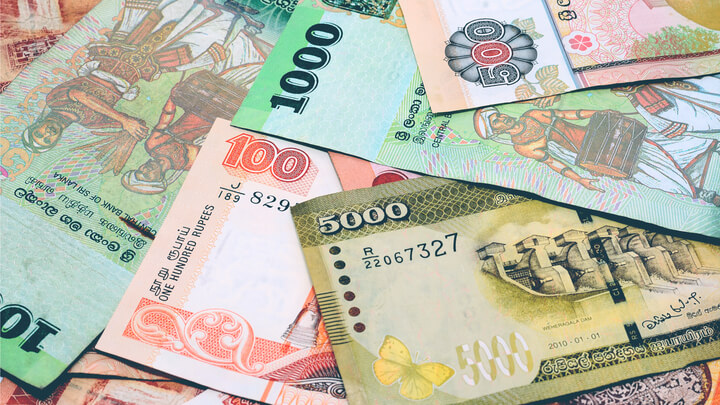Sri Lanka’s 213 billion rupees printing of money on July 26 (1005 million US dollars at 203 rupees) had flowed out of the country in a back-to-back transaction that depleted foreign reserves but did not cause domestic price inflation, Treasury Secretary Sajith Attygalle said.
The billion US dollar sovereign bond (which also had a coupon) was paid with central bank dollar (monetary) reserves.
He said a Treasury bill was issued to the central bank to get rupees.
“We paid 1000 million from reserves. That means the reserves of the central bank,”
“Then I have to take rupees from the central bank to get dollars. This is how it happens,” Attygalle said.
“Yes. The Treasury bill holdings of the central bank went up by that amount. But there is nothing that came out to the (banking) system.”
He said the money printed by the sale of Treasury bills to the central bank did not come into the banking system. If people were worried about (price) inflation it would not happen, Secretary Attygalle said.
The money printed to repay foreign loans does not cause domestic inflation because the money does not come into circulation.
“But that money does not get into circulation,” he said. “What is the problem with printing? Inflation goes up. Inflation goes up when the money comes into use.”
“For me to get dollars from the central bank I have to print money and give in rupees. That is what was done. As a result it (the printed money) did not come to money circulation.”
Inflating reserve money
Classical economists object to money printing (inflation of reserve money above the monetary anchor) as it causes reserve losses and foreign exchange shortages (rationing of dollars in a pegged regime), asset price inflation as well as (commodity) price inflation in an index which leads to rationing of goods, price controls and shortages.
When money is printed to repay foreign debt, there is an immediate loss of forex reserves.
However even if money is printed for domestic expenses such as state salaries (deficit finance), the cash will end up as forex reserve losses when state workers buy food or other imported goods, travel around or save money in bank which are loaned for investment projects which result in steel or other intermediate imports.
Through several rounds of credit including for government capital expenditure through state bank overdrafts, all the printed money will end up as reserve losses or a balance of payments deficit.
“Our economy was and is both small and open. Financing budget deficits through Central Bank credit creation appeared to us as an invitation to disaster,” Singapore’s first Finance Minister who kept a Colonial currency board rejecting Keynesian central banks has said.
“There was no effective way of exchange control in an open trading economy like ours to deal with the inevitable balance of payments troubles.”
“The Keynesian system is a closed one, that is, it takes no account of foreign trade.
This is admissible in theory, but in practice, since all modern states engage in foreign trade, a Keynesian stimulus will lead eventually to balance of payments deficits if government do not exercise restraint in time.”
Instead of the central bank, even if part of the Treasury bills were issued to the public and banks (and banks did not use window money to buy them) domestic credit and consumption would have been reduced and the central bank would not have had to lose a billion US dollars in reserves.
Treasury itself would have been able to buy some dollars in the market from the real money borrowed or taxed from the public or their savings in banks.
The central bank also would be able to recoup some of the losses, if it is able sell down the Treasury bills slow domestic credit and imports which would result in an excess of dollars inflows over outflows in subsequent weeks.
Defending a Treasury Bill yield vs Rupee
However it cannot be done since the central bank is defending a 5.26 percent ceiling Treasury bill yield in bill auctions at which new money is printed and the monetary base and excess liquidity is expanded. When excess liquidity is used, forex shortages are triggered.
Last week about six billion rupees were printed in this fashion after a failed bill auction.
In 1950 and 1951 around the time Sri Lanka’s Latin America style central bank was set up, the US Fed faced the same problem as the economy recovered strongly after the end of World War II.
Mercantilists and the popular financial media called it the ‘Korean War boom’ implying that the US was running budget deficits for defence. However budget deficits themselves cannot create external deficits or domestic inflation, unless they were re-finance with central bank credit.
What outsiders call the Korean War boom was actually caused by Fed purchases of Liberty Bonds (a US Treasury security issued to fund World War II) at a fixed rate at time the budget was in surplus, according to Governors of the Fed.
In 2018 Sri Lanka printed money despite taxes being raised under ‘flexible’ inflation targeting and sent the rupee careening down from 153 to 182 by denying convertibility to the new rupee through a ‘flexible’ exchange rate.
“There is going to be nothing for us to protect in this country unless we are willing to do what is necessary to protect the dollar,” Fed Governor Marriner Eccles who was a former chairman said in comments set out in the Fed minutes of February 6-8, 1951, which are now public.
“Our responsibility is not a minor one; it is a very great one under the conditions that exist, and if we fail, history will record that we were responsible, at least to a very great measure, in bringing about the destruction or defeat of the very system that our defense effort is being made to protect and defend.
“We are not in a war. We do not now have deficit financing.
“You only protect the public credit by maintaining confidence in the Government and in its securities and to the extent the public will buy and hold those securities. The thing we are doing is to make it possible for the public to convert Government securities into money and to expand the money supply of this country by $7 billion in six months.”
Over 2020 Sri Lanka’s central bank bought 650 billion rupees of government securities, by rejecting bids at auctions, some newly issued, others already held by banks and the public from past deficits, injecting rupee reserves to banks Liberty Bonds style of the Fed.
“That was not done for the purpose of carrying out our responsibilities, but for the purpose of trying to hold the interest-rate structure,” Governor Eccles said.
“It was due entirely to our efforts to carry out the demands or requests of the Treasury.”
“I, for one, feel that the issue has to be faced. When you think that we have bought $3-1/2 billions of Goverment securities since last May, during a time when the Government has had a budget surplus, which has been anti-inflationary, it is apparent that we have provided the means for the growth in the money supply, which has been directly related to the increase in cost of living and the price level.”
In Sri Lanka out of the 650 billion rupees printed in 2020 and two reserve ratio cuts, only a part went to fill a need of public currency holdings. The reset flowed out as a 2.3 billion US dollar balance of payments deficit. About 200 billion was left as excess liquidity by the first week of January.
By May a billion US dollar balance of payments deficit had consumed the excess as well as more money printed by defending the 12 – month bill yield.
In addition to rejected bond bids, central bank data showed that in fact 103 billion rupees had been injected via the 5.5 percent window by Friday. Almost a similar amount was however parked in the central bank by better managed banks which can be used for final clearing of transactions every day.
Inflation and Price Controls
In July 2021 the Colombo Consumer Price Index hit 5.7 percent, higher than the 5.5 percent ceiling policy rate at which money is printed and higher than the 5.26 percent de facto policy rate at which large volumes of money is injected by rejecting public bids at higher rates.
Sri Lanka’s National Consumer Price Index had already hit 6.1 percent in the previous month, higher than the 4-6 percent inflation target that the central bank is said to be following despite having a pegged exchange rate regime.
Trade Minister Bandula Gunewardene had said fines for those breaking price controls would be raised 4,000 percent, from 2,500 to 100,000. Argentina style precios cuidados are planned to contain soaring rice prices.
“It seems to me that this is an issue that we ought to be prepared to stand up to, as any soldier would stand up in times of great stress, and face our responsibilities to the American public,” Eccles said.
“We are almost solely responsible for this inflation…the whole question of having rationing and price controls is due to the fact that we have this monetary inflation, and this Committee is the only agency in existence that can curb and stop the growth of money.”
“We can not pass this responsibility; we should tell the Treasury, the President, and the Congress these facts, and do something about it.”
Shortly thereafter in 1951, the Treasury Fed Accord was signed giving independence to the Fed. The Fed maintained independence up to 1969 under Chairman William McChesney Martin.
President Richard Nixon caused his resignation and appointed output gap targeting Arthur Burns to avoid a rate hike. The US dollar collapsed in 1971, the Bretton Woods system disintegrated and the gold standard ended, along with the imposition of ‘Nixon’s Shock’ trade controls.
Analysts have faulted the International Monetary Fund for giving technical advice for Sri Lanka’s central bank to print money and target an output gap, Burns style, despite operating a forex reserve collecting peg.
EN’s economic columnist Bellwether says in 1795, the Bank of England faced a run on is gold reserves (a BOP deficit) when Britain’s usury laws prevented it from raising the discount rate above 5 percent coincidentally around the ceiling 12-month yield that is now defended in Treasuries auctions.


